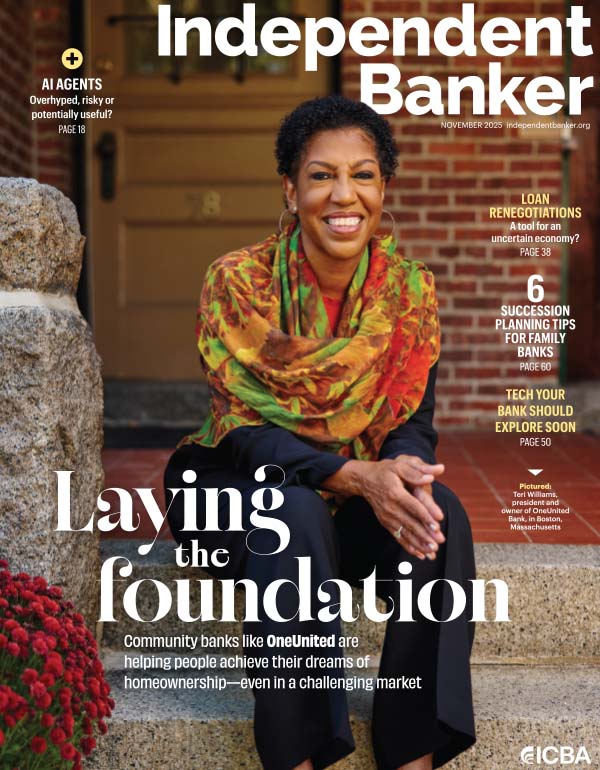According to FIS, 50% of customers abandon a digital loan application if it takes more than three to five minutes to complete.
“As consumers, we still think about our experiences with Apple, our experiences with Amazon, and want to apply that to every other e-commerce experience we have,” says Charles E. Potts, ICBA executive vice president and chief innovation officer. While bankers may not think about a loan or a checking account as something to shop for, that’s what potential and current customers do. And to meet customers’ expectations, community banks must upgrade their digital experiences.
“We’re at the point that having the best possible digital experience is no longer just a cool thing that sets you apart from your competitors,” says Joshua Jordan, digital engagement director at financial technology company Jack Henry. “It’s table stakes.”
Here are some examples of how community banks have gone through this process, for the good of their bank, their employees, their customers and their bottom lines.
Seeing the writing on the digital wall
50%
of customers abandon a digital loan application if it takes more than three to five minutes to complete
Source: FIS
Sometimes, the push to revamp the digital customer experience can be a practical one, as it was for $586 million-asset Commencement Bank in Tacoma, Wash. Its contract with its software vendor was about to expire, and Commencement would either need to stick with its core system or make a change.
“When we looked at our legacy system, we saw that we wanted to accomplish 10 new things,” says John Manolides, CEO of Commencement Bank. These 10 tasks included allowing customers to open an account online and deactivate their debit card if they think they lost it, and enabling the bank to more quickly spot potential fraudulent transactions.
According to Manolides, the community bank realized that “it would take us about two and a half years to get all 10 things in place” with its older system. So, bank leadership decided to move to a core platform that would make enabling those kinds of functions easier.
Bell Bank in Fargo, N.D., was also aware that it needed to change the way it digitally presented itself to customers. Laura Orcutt, senior vice president director of product at the $13 billion‑asset community bank, knew it was a problem. While the bank’s primary markets are in Minnesota, Arizona and North Dakota, it also underwrites loans in 30 states plus the District of Columbia.
“We acknowledged we need to be able to provide services to customers whenever they want to do their banking,” Orcutt says, especially as the bank is working to “attract customers across the nation.”
Meanwhile, $640 million‑asset Climate First Bank in St. Petersburg, Fla., had relatively new digital platforms, as it has only been in business since June 2021. However, according to senior vice president and chief of staff Chris Cucci, within eight months of opening, the community bank realized it couldn’t succeed unless it revamped its consumer lending process. That meant working on its loan application process so that staff could make a lending decision almost immediately, because its competitors—which it sees as fintechs rather than banks—were giving almost instant approvals.
Hashim Toussaint, SVP, general manager of digital solutions at FIS, says that before a community bank does anything involving a tech upgrade, it needs to “articulate and define for what you’re trying to solve.” Are you trying to grow your customer base? Attract new customers? Expand your share of wallet for existing customers? Identifying a goal can help you decide what to address first rather than trying to take a “big bang” approach of upgrading everything all at once. This approach can be frustrating and drawn out and may ultimately not lead to the right long-term solution.
Taking the first big step
An e-commerce experience in the banking world
While no one expects a community bank to deliver toilet paper and pens in 24 hours, customers do expect their banking experience to be on par with those of Amazon and other technology giants.
According to the Zendesk Customer Experience Trends Report 2023:
72%
of customers want immediate service
70%
expect anyone they interact with to have the full context of their query
62%
think experiences should flow naturally between physical and digital spaces
62%
agree that personalized recommendations are better than general ones
Even the mere idea of upgrading digital platforms can be daunting for a community bank that is “too small of an organization to employ someone on staff who’s thinking about all this,” says Sanat Patel, chief lending officer of Avana Companies, which owns $42 million‑asset First State Bank of Abilene in Abilene, Texas. Bigger banks typically have a chief technology officer whose job it is to focus on strategic initiatives, whereas at smaller banks, several people may fill that role. Community banks may also think it’s too cost prohibitive to start a digital transformation and could be overwhelmed when trying to think about how to upgrade everything.
Instead of tackling it all at once, Patel says First State Bank of Abilene picked one pain point and started there. For the community bank, it was consumer lending. “We started following the journey of a loan and built technology around it,” he says. From loan origination to underwriting to closing and servicing the loan, bank staff were “following the loan and following the experience of the borrower in a thoughtful way and their experience with the technology.”
Commencement Bank started its digital transformation journey with ICBA, by working with Potts and his team to create an information technology strategy plan that went along with the bank’s normal strategic plan. Commencement then partnered with a consulting firm to create a plan for how to move forward, which also meant recognizing that it didn’t have the in-house knowledge to do this itself and knowing that “they’re bankers, not technology people,” says Manolides. Acknowledging this helped make it easier to decide to partner with someone who was.
No digital transformation will run 100% smoothly, but banks can iron out any bumps through advance planning. Commencement Bank, for example, planned for more than a year.
Banks also need to be getting—and listening to—constant feedback during planning, building and implementation. It helps to “be open minded about what you’re being told from a vendor or a consultant, because they’re exposed to [the technology] way more often than you are,” says Jordan of Jack Henry.
Of course, digital transformations can take a year or longer, so it also helps to have “quick wins,” says Toussaint, to keep momentum going. That might mean looking for ways to “wrap [new technology] around old technology and still deliver that value,” which will be different depending on the bank, the technology and what you're trying to do.
Bell Bank worked to ensure that everyone at the bank was committed to the digital transformation project, and that it stayed a top priority instead of something pushed onto one group and checked in on every now and then.
“We needed that continued support across the organization to be excited and proud of what we’re doing, and also understand that we can’t take our foot off the gas or we will not heed the deadlines we established,” Orcutt says.
New technology is also easy to test before going live, says Jordan. Banks can do that by utilizing a “sandbox environment,” where people can test software and check out how a customer would interact without actually affecting how they’re banking right now. Jordan suggests having employees and their friends and families test out the technology to get feedback from people of different backgrounds and generations.
More from ICBA
Dive into and learn more about the world of digital transformation through ICBA's five-part webinar on demand series, Digital Transformation Demystified. icba.org/education/webinars
All on board
A digital overhaul will mean a shift for your customers, but it’s also a big—maybe even bigger—change for employees. Commencement Bank made sure the task force leading its project focused on communication with employees, which included letting everyone join project-related huddle meetings.
“Anybody who was impacted became part of the process,” Manolides says. The community bank created newsletters with updates on progress and held bank-wide meetings addressing the conversion and including trivia games about product knowledge, with prizes for winners. “We tried to make it as fun as we could and not be intimidating,” he says.
The community bank created an internal employee website with information about the digital transformation, whether they had missed a meeting and wanted to catch up or were looking for more information about a specific aspect of the project. It was also part of employee engagement surveys—which asked questions about what was frustrating, what didn’t work and what about the process might have created fear—so that the bank could address those issues as quickly as possible.
Bell Bank took a similar approach and engaged employees in the process. That engagement was reinforced when the new website launched, says Orcutt. “Just visually as soon as you see [the new website], you say, ‘Oh it looks clear, it looks crisp, it doesn’t look like three different people put together one page.’”
Community banks can also focus on how much easier these new systems make employees’ jobs. Avana, for example, created a dashboard for bankers to use.
“When the team logs into the dashboard, the loan’s there,” Patel says. “The data’s there to know if the deal is viable or not. They can quickly look at it to make sure the loan confirms and then we’re done.”
Reaping the benefits
After identifying that its greatest need was speeding up the loan process, Climate First Bank spoke to technology providers about its options and decided to keep its legacy system but develop a loan demand generation and point-of-sale application to overlay the legacy lending system.
“We realized we were happy with the legacy bank solutions. We just don’t like the user experience,” Cucci says. Now, instead of a loan taking days or even a week to be approved or declined, customers can fill out a loan application in an average of three minutes and get a decision within 30 seconds.
Commencement Bank launched its new platform in August 2023. In less than a year, it’s found that the new solution is not only more cost-effective but has also addressed eight of the 10 issues the bank set out to cover. The other goals are “on the road map, and they’re coming in quick succession,” Manolides says.
The community bank was also able to improve its customer service by meeting more customers where they are and on whatever platform they prefer, which Manolides says is critical to the bank’s brand and customer retention.
Bell Bank launched its new platforms in May 2023 and has since seen a 65% increase in users on its website.
“That’s huge in itself. I don’t know if we would have had that success if we would have waited another year [to do the update],” says Orcutt. The community bank was able to roll out digital account opening for consumer deposits, consumer loans and for a range of business products, including digital account opening and CDs.
Since the transformation, Bell Bank has also seen increased usage of its mobile app not just with their younger customers but across all generations.
So, while a major digital transformation can be disruptive, costly and complicated, establishing clear goals up front and keeping staff and customers informed will reap benefits for everyone.
Don’t forget the human touch
While community banks are competing in the digital landscape with much bigger financial institutions, they shouldn’t forget why their customers choose to bank with them, even if they decide to engage with the bank digitally first.
“As a customer, there should always be an opportunity for me to hit the magic eject button and get to a person,” says Charles Potts, ICBA executive vice president and chief innovation officer. “Don’t send me down a force-fitted digital rabbit hole and just leave me up to the digital gods.”
Part of the planning process must include identifying the appropriate places where a customer can interact with a human being.
“It’s a huge value proposition to pair the high tech with the high touch nature of what differentiates community banks from a lot of larger institutions,” Potts says.






